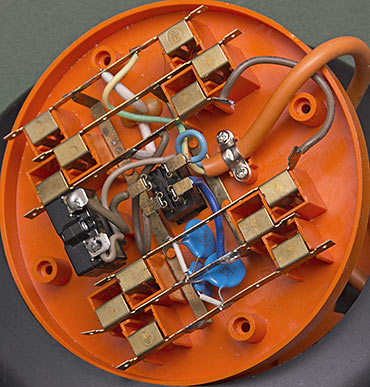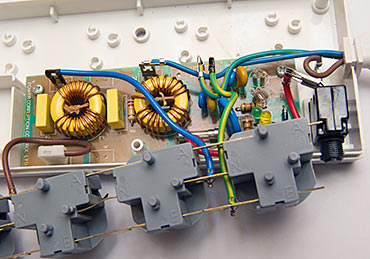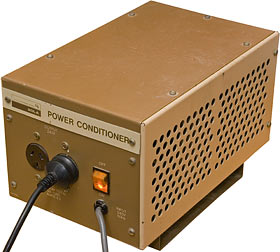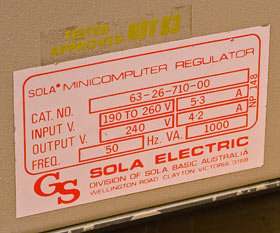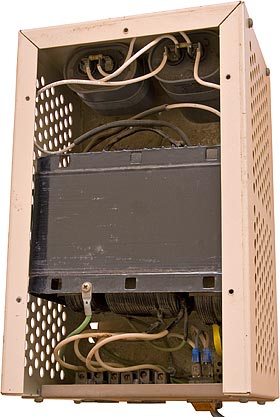
Power struggle
Originally published 2004 in Atomic: Maximum Power Computing Last modified 15-Jan-2015.
Let's talk about the endlessly fascinating, entertaining and, let's admit it, somewhat arousing topic of power filtering.
Most computer users are vaguely aware that it's a good thing to filter the AC going into your precious multi-gigahertz baby. Surges and spikes can blow it up, slumps and blackouts can shut it down.
Here in Australia, we generally have pretty good AC power. Hook up an RMS voltage (and, if you're fancy, also phase) meter to the AC supply and you'll see it wandering all over the place from the 230-volt sine wave it's meant to be, but that's cool; things that plug into the mains are made to cope with some degree of input lousiness. PC Power Supply Units are, generally, more tolerant of weird input than most appliances.
But when the guy next door starts playing with his new million-amp welder, or your elderly fridge and freezer both click their squeaky old compressors on at the same time, or lightning strikes a suburb away, it's quite possible for big nasty spikes to appear on the mains. Those can toast PSUs, and possibly other equipment as well. Nearby lightning strikes are particularly nasty, since they can put large currents on phone and cable TV wires, frying computer gear that way even if the power cord isn't plugged in any more.
So you buy a surge/spike protector powerboard and you're fine, right? After all, there are quite a few brands of powerboard that now come with an impressive "Connected Equipment Warranty", offering thousands or even tens of thousands of dollars of insurance if something plugged in through the powerboard gets toasted. How can you lose?
Well, you can lose technically, and you can lose legally.
The technical side is simple enough. No ordinary cheap powerboard ("cheap" definitely includes "a hundred US bucks") actually provides very good protection from line current gremlins. It may protect you once from a big-ish spike, or several times from smaller ones, but it won't last forever.
Cheap surge filters are all based around components called Metal-Oxide Varistors (MOVs). MOVs pass current only when the voltage across them is above a set value, and they react to overcurrent in microseconds. A circuit breaker or fuse can take tens of milliseconds to trip or blow; that's much too slow for spike suppression.
Here are the guts of such a powerboard. This one's round, not the usual rectangle, but it contains the same components you'll find in a normal "surge suppressor". There are four power outlets whose contacts are made out of bent copper sheet, integral with the busbars connecting them. There's a switch, which not all powerboards have. There's a circuit breaker that trips if the powerboard is overloaded, and is unlikely to be of any help with spikes or surges. And there are three blue circular MOVs. (Blue is the usual colour for MOVs, for some reason.)
Unfortunately, MOVs will only work a few times, at best. The more work they have to do, the closer to death they come. A surge/spike powerboard with a toasted MOV is now... just a powerboard.
Better surge/spike boards are meant to tell you when their MOV's died via a little light or even a buzzer, but they commonly, actually, don't. A surge/spike filter that's been in use for some years and still reports its MOV as perfectly healthy is, probably, lying.
Better surge suppressors use two other kinds of spike-sinking component. Gas arrestor tubes (also known as gas discharge tubes, or GDTs) are much tougher than MOVs, but respond too slowly to be useful for many applications, including computer protection. But you'll still find them in the better power filters, because they can handle the load of a really big surge, after some other component has (possibly) bravely given its life to intercept the first several microseconds of overvoltage.
And then there are Silicon Avalanche Diodes (SADs), which are between gas tubes and MOVs in toughness, but as fast as a MOV. They're more expensive, though, which is why cheap surge/spike filters never contain them.
Here's the inside of a better surge/spike-protector powerboard than the round one above. It's got all the same stuff as the round powerboard, except for a power switch. In addition, though, it has a few status-indicator lights (and supporting resistors and tiny capacitors) that say everything's hunky-dory, even though this board is many years old and its MOVs surely wore out long ago.
And, more noticeably, this powerboard has a couple of toroidal inductors, side-by-side with a pair of yellow rectangular 250-volt, 0.1-microfarad capacitors.
In the time-honoured water-flow-through-a-water-filled-hose metaphor for electricity going through a wire, a capacitor can be thought of as a rubber membrane blocking the hose. It'll pass the motion of "alternating water" - when the water goes one way and then the other, bulging the membrane to and fro - but it won't pass "direct water" - when the water goes in only one direction. Then, the water will stretch the membrane to whatever capacity the water pressure (analogous to voltage) can manage, and then no more water will flow. (But if you let the pressure off, the membrane will snap back and make water flow in the opposite direction, until it's unstretched again.)
Capacitors in your surge/spike-filter powerboard can, therefore, block or at least reduce unexpected chunks of direct current that're polluting your alternating-current mains. As far as saving your gear from real-world damage goes, small capacitors are of little use, but they're also inexpensive and better than nothing.
Inductors can be more useful, but are more difficult to explain using the water analogy. An inductor is an electromagnet; it builds up a magnetic field when direct current is applied to it. If the field builds up to its maximum for a given voltage, the direct current will then flow straight through the inductor as if it were just so much un-coiled wire. But if the current reverses - as it does all the time, if it's alternating current - the field has to collapse and re-fill going the other way before the inductor behaves in a wire-like fashion again. So you can model inductors as being a bit like a bucket with two pipes going in at the bottom, which has to fill up significantly before more than a trickle of water will pass through it, but that doesn't really model the AC behaviour of an inductor properly.
The purpose of inductors in a surge/spike protector is to sit across the active and neutral wires and, once again, to reduce the amount of DC that can make it to whatever's plugged into the powerboard, by passing that DC straight from active to neutral.
Like the capacitors, small inductors are not much use against genuinely dangerous mains-power pollution. But once again, they're better than nothing.
Both of the above surge/spike filters are pretty inexpensive consumer products, so neither of them include the much more effective gas-arrestor tubes or SADs. The fancier one with the caps and coils is marginally better, but in the real world is unlikely to actually help significantly.
The best surge/spike suppressors have gas arrestor tubes and SADs, and possibly MOVs as well. Proper "power conditioners" go on to include a great big heavy iron transformer, whose resonance is tuned to 50Hz (or 60Hz, in countries that use that mains frequency), and has immense inductance that blocks surges and spikes quite well all by itself. This makes the power filter large and heavy and easily as expensive as a mid-range Uninterruptible Power Supply (UPS), but if there's an aluminium smelter down the road from you, this is the kind of filter you want.
In case you're wondering what one of these "ferroresonant" power conditioners looks like - it looks like this.
I picked up this elderly Sola unit cheap on eBay. The price including delivery (by a postman who asked me what the heck this hernia-inducing box contained) was slightly more than a tenth of what newer versions of the same thing commonly cost, even second-hand.
(You may be able to find your own monster power conditioner cheap on eBay - here for Australia, here for the USA, here for Canada, here for the UK - but most cheap ones, especially cheap ones with cheap delivery, have pretty low capacity.)
My conditioner has an Institutional Greenish-Beige paint job and a magnificently retro label...
...which suggests that this thing may have fed a VAX or something at some point. But, essentially, this relic is very much the same as a modern ferroresonant conditioner.
If you think that probably means that not a lot of innovation has happened in the area of ferroresonant power conditioner design in the last 30 years, you're right. Inside, there's the gigantic transformer (which accounts for most of the thing's roughly 28-kilogram weight - I think the seller knew a guy who slipped this overweight parcel into the postal system...), a bit of wiring, and a couple of hefty capacitors.
That warning label isn't kidding, but the drain resistors across the caps are still working perfectly, so moments after the conditioner's turned off, there's no charge left in the caps.
Eagle-eyed readers will also be able to see, in the full sized version of the above image, that these are "soggy foil" capacitors. Against all reason, that's a real kind of capacitor, and these ones still seem to be OK. The whole conditioner, in fact, still works fine, as far as I can tell; in that first picture of it, it's running a thousand watts of photo lights.
It's possible that this conditioner doesn't have the greatest possible output waveform - old ferroresonant regulators deviated a pretty long way from a sine wave - and I haven't hooked a 'scope up to it to see. But when I plugged a desk fan into the conditioner, the fan motor only hummed slightly louder than it did from ordinary wall power, which is a good sign. And many non-motor devices don't care about power waveform, anyway. Switchmode PSUs like those used by all PCs certainly don't.
You don't necessarily want to have an old-model power conditioner sitting next to your desk, though, for two reasons. One, these conditioners themselves hum quite loudly. The strong oscillating electric fields that make a transformer work also make it vibrate, and you can hear the timbre of the sound (and, in this case, probably also the output waveform...) change as the load on the transformer changes. Modern power conditioners have UPS-style warning beepers to tell you if you're overloading them. Old ones like this expect you to keep track of the load yourself. Or, failing that, just know what an overload sounds like.
(The Sola conditioner just cuts out when it's overloaded.)
Ferroresonant conditioners also make a distinctive sound when
fired at you
turned on, as the simple tank circuit
"fills up" with energy. Here that noise
is. It's vaguely reminiscent of an engine starting, or twanging a ruler on the edge
of a desk. It's not the sort of sound you expect a solid-state device to make.
The other reason why you might not want an old heavyweight conditioner like this is that it's rather inefficient. The Sola draws about 140 watts all by itself, whenever it's powered up. This makes it run rather warm, too.
Fortunately, it's now possible to buy lightweight power conditioners that can run just as much gear as the old monsters. I think they usually don't have the same protection capability as ferroresonant conditioners, but they also only waste a single-digit number of watts by themselves, at most. Some of them are basically just the filtering components from a decent UPS turned into a standalone product; see APC's Line-R products, for instance, or the ones I talk about here.
(The Line-R conditioners have been around for long enough now that used ones show up quite regularly on eBay, and because they're not horrendously heavy the delivery prices are often quite tolerable, too. The standard beginner's mistake in buying a used Uninterruptible Power Supply is to buy one with dead lead-acid batteries that are still inside the casing and make the thing cost a fortune to ship; you should try to find a seller who knows to remove dead batteries. Line conditioners don't have any batteries to weigh them down in the first place, or any other components that are likely to be dead when the conditioner's five years old.)
Anyway, if your local power is crummy enough, or your equipment is valuable enough, that you can justify buying a power conditioner, then rather than faff around buying tons of flaky powerboard filters for all of your electrical outlets, you can get an electrician to install one giant power conditioner at your fusebox. It won't be cheap, but now the whole house should be bulletproof. And it's a conditioner, not a UPS, so maintenance costs should be low to zero, unless the conditioner gives its life to protect everything else in the house from a monster lightning spike.
You can even get whole-house UPSes, but that's almost certainly overkill. UPSes with moderate filtering capacity just for your computer equipment will do for most users.
So that, finally, is it for the technical problem with cheap surge/spike filters.
The legal problem has to do with those increasingly popular Connected Equipment Warranties (CEWs).
You can read a sample Belkin Connected Equipment Warranty in PDF format here, or a Panamax one (also PDF) here. I'm afraid they go on a bit, so you might like to skip actually reading them.
I took the time to plough through them, though. So I know that first up, you'd better still have the receipt for your surge protector. The Connected Equipment Warranty probably only covers the original purchaser.
And if you can find a cheap power filter whose CEW covers new-for-old replacement of damaged equipment, I'd like to see it. Normally, they give you blue-book used value for your gear. Blue-book value for a tweaky overclocked "enthusiast" PC with a fast graphics card may be the same as for a bargain-basement Dell with similar basic specs. CEWs also often leave the guarantor the option of having the equipment repaired, rather than replaced. And of making you pay to have your exploded computer shipped to whatever repairer they choose.
If the guarantors really want to weasel out of the deal - which they won't necessarily, but we're talking about the insurance industry now, so anything's possible - they can insist on proof that every wire going into the toasted equipment was protected with their gear. Were you using an extension cord? Were you overloading the surge protector (did you plug your laser printer into it?). Hey, maybe the spike was just bigger than the filter was meant to deal with!
Did the filter protect you from a spike last week, burn out, and so not protect you from a spike this week? If so, then no payout.
Bit of a Catch 22 there, really. If the filter's not burned out then they can say you didn't have it plugged in at all, and if it is then they can say that it was dead already, and you should have stuck your head behind your desk every day to see whether the little orange light had gone out.
The take-home message from all of this is that quality power filtering isn't cheap. Fortunately, though, most people here in Australia and much of the rest of the civilised world don't need quality power filtering.
To Aussies at least, I therefore say: Go ahead and buy dirt cheap no-CEW filter-boards, and be merry.
